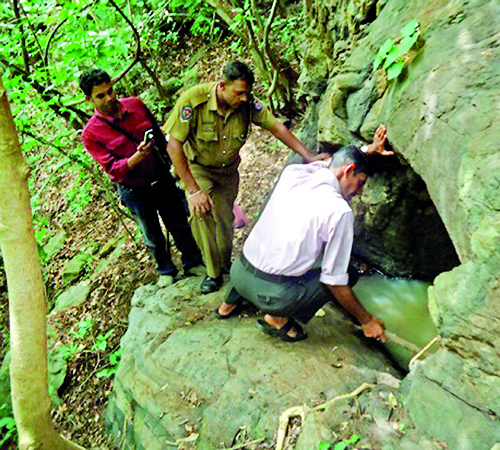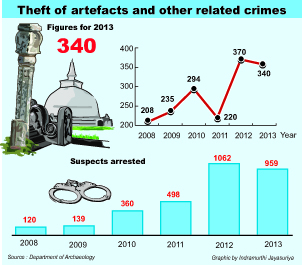News
Cultural treasures pillaged every day
An upserge in the number of treasure hunters since the beginning of the year is putting Sri Lanka’s cultural heritage under serious threst, warn archaelogists.
There were 27 botched attempts last month despite the threat of punishment by the sites’ guardians, both human and supernatural.
They are abandoning crowbars and shovels for mechanised equipment to search for valuables – a practice that will lead to wide

Four people were arrested last week inside this forest reserve in the Badulla area while they were pillaging an archaelogical site belonging to the Anuradhapura period. Here police and Archaelogical Dept. officers are seen at the site. Pic by Palitha Ariyawansa
destruction in the sites where archaeologists normally take pains to use fine tools to uncover relics without risking harm to hidden nearby objects.
The thieves are using backhoe machines and other motorised equipment to gain quick results, the Department of Archaeology said.
In Mundalama last week a gang of five was arrested with two backhoe machines, a lorry, and a car. This is now a common occurrence, the department said.
The Department of Archaeology’s Director General, Dr. Senerath Banda Dissanayaka, said the promise of quick cash led thieves to risk the wrath of the guardian deities.
“When a story spreads that a treasure hunter has found something valuable in the area many others will come into the same area. We have noticed such waves of incidents taking over in certain places,” Mr Dissanayaka said.
The highest number of lootings is reported from the North Central Province; the North Western province is also a popular target.
The Northern Province, which reported no incidents in 2008, has seen a steady increase in looting of historic sites following the end of the civil war in 2009. In 2012, eight incidents were reported, and the number more than doubled to 18 last year.
The Sunday Times learns that most of the offenders arrested in the Northern Province are individuals who have travelled from the south for the specific purpose of looking for hidden valuables.
In all cases a few villagers are roped in to the illegal venture. The masterminds behind the work are rarely revealed.
“We rarely find connections outside the immediate group arrested in each incident,” Dr. Dissanayaka said.
“Often they don’t reveal the names of other parties who are involved.”
The current ordinance governing illegal excavations for archaeological items only imposes a fine of only Rs. 50,000 or a jail term of two years if found guilty. The laws do not provide room to prosecute any party who might be commissioning the work.
 “We will be amending this soon to give more powers and scope to the legislation,” Dr. Dissanayaka said. “The draft is now with the Legal Draftsman.”
“We will be amending this soon to give more powers and scope to the legislation,” Dr. Dissanayaka said. “The draft is now with the Legal Draftsman.”
The Department of Archaeology has a specific unit investigating the robbing of valuables from historic sites.
The unit said 340 acts of thieving were recorded last year. Of these, 48 acts had tragically resulted in the destruction of the historic habitat. There were 959 arrests and more than Rs. 43 million collected in fines last year.
Over the past five years, site robbers arrested have included 66 military personnel, 34 persons in Buddhist robes and 31 Police STF members. Among items stolen and later confiscated were 16 Buddha statues, four statues of deities and 58 ancient coins.
In 2012, 309 incidents were recorded, with 1062 arrests.
Many robbers are tricked by their agents in the quest for ancient valuables.
“Most of them are fooled by the “kattadiyas” or other middlemen into believing that there is treasure in various places,” Dr. Dissanayaka said.
“When they insist that there is a particular rock formation which is supposed to be a sign, the robbers who want to believe this story will hold to it no matter how far-fetched the idea may seem to an outsider.”
The archaeology chief said many middle men made much more money from the treasure-hunting rackets than did the robbers themselves.
“Many of (the middle men) sell maps and other documents claiming these give directions to hidden treasures.”
But the hunters rarely found any valuables.
“They look for gold jewellery, gems and statues made in gold or other valuable material. But often they don’t find such items,” he said.
“Most often they would find ancient scriptures, or statues which only have a thin layer of gold. On one occasion we confiscated a crown which was said to be King Dutugemunu’s. But when we tested it for authenticity it was a cheap replica – it only had glass stones.”
The department is responsible for 250,000 archaeological sites, and ensuring the security of every single site is no easy task.
“Polonnaruwa is just one site out of the 250,000 and it alone needs about 100 guards to secure the area, a nearly impossible task,” he said.
Dr. Dissanayaka appealed to the public for help in protecting the national heritage.
“This is a task that the police and the department alone cannot do. We need the public to be vigilant and report any suspicious activity,” he said.

